
|
Now it is 11.2 mag (Mar. 20, Juan Jose Gonzalez). It stays bright as 11 mag for a long time. In the Southern Hemisphere, it is not observable for a long time after this. In the Northern Hemispehre, it stays observable for a long time until the comet fades out. But it will be getting lower gradually after this.
Date(TT) R.A. (2000) Decl. Delta r Elong. m1 Best Time(A, h)
Mar. 24 4 20.27 35 36.8 2.874 2.649 67 10.9 19:39 (106, 49)
Mar. 31 4 28.11 37 8.9 2.948 2.636 62 10.9 19:45 (111, 44)
|
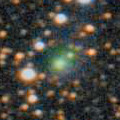
|
Now it is bright as 11.3 mag (Mar. 24, Marco Goiato). It is expected to brighten up to 9 mag in summer. In the Southern Hemisphere, it stays observable in good condition for a long time until the comet will fade out. In the Northern Hemisphere, it is observable only until June.
Date(TT) R.A. (2000) Decl. Delta r Elong. m1 Best Time(A, h)
Mar. 24 19 30.49 -1 33.4 2.887 2.716 70 11.6 4:34 (303, 36)
Mar. 31 19 34.55 -2 33.5 2.737 2.672 75 11.5 4:23 (307, 37)
|
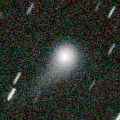
|
Now it is 12.0 mag (Mar. 20, Juan Jose Gonzalez). It stays 12 mag for a long time until spring in 2019. In the Northern Hemisphere, it stays observable in good condition for a long time, although it becomes unobservable temporarily from mid June to August. In the Southern Hemisphere, it is not observable until September.
Date(TT) R.A. (2000) Decl. Delta r Elong. m1 Best Time(A, h)
Mar. 24 9 29.52 78 3.9 2.624 2.932 97 12.1 21:19 (180, 47)
Mar. 31 8 41.55 74 53.3 2.658 2.903 93 12.1 20:06 (180, 50)
|
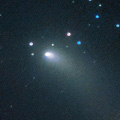
|
It brightened up to 9-10 mag from December to February. Now it is fading very rapidly. It has already faded down to 16.4 mag (Mar. 15, Jean-Francois Soulier). In the Northern Hemisphere, it stays extremely low after this. In the Southern Hemisphere, it will be getting higher in the morning sky after this, then it stays observable in good condition.
Date(TT) R.A. (2000) Decl. Delta r Elong. m1 Best Time(A, h)
Mar. 24 21 46.96 -5 37.7 1.441 0.875 36 12.3 4:34 (282, 7)
Mar. 31 21 52.92 -10 18.7 1.435 0.983 43 12.7 4:23 (287, 7)
|
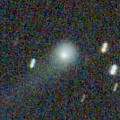
|
Now it is very bright as 12.8 mag (Mar. 12, Seiichi Yoshida). It will be observable at 12-13 mag for a long time from 2017 to 2018. In the Southern Hemisphere, it will be hardly observable after this.
Date(TT) R.A. (2000) Decl. Delta r Elong. m1 Best Time(A, h)
Mar. 24 15 52.52 48 7.5 3.261 3.741 111 12.9 3:48 (180, 77)
Mar. 31 15 36.71 50 37.6 3.239 3.746 113 12.9 3:05 (180, 75)
|
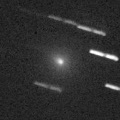
|
It brightened up to 11 mag in February. Now it is fading. But it is bright as 13.2 mag still now (Mar. 18, Chris Wyatt). It stays observable in the evening sky until the comet fades out.
Date(TT) R.A. (2000) Decl. Delta r Elong. m1 Best Time(A, h)
Mar. 24 3 50.76 9 16.1 1.480 1.224 55 13.2 19:39 ( 79, 31)
Mar. 31 4 20.72 10 15.7 1.546 1.286 55 13.8 19:45 ( 81, 31)
|
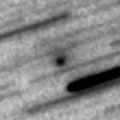
|
Now it is 17.6 mag (Feb. 18, Martin Masek). It will brighten rapidly after this, and will brighten up to 12 mag from April to June. In the Southern Hemisphere, it stays observable in excellent condition. In the Northern Hemisphere, it will be unobservable from April to June when the comet becomes brightest.
Date(TT) R.A. (2000) Decl. Delta r Elong. m1 Best Time(A, h)
Mar. 24 18 22.90 -36 0.4 1.134 1.488 88 15.9 4:34 (338, 15)
Mar. 31 18 56.18 -37 43.5 1.070 1.446 88 13.6 4:23 (336, 12)
|

|
It is not observable now. It will appear in the morning sky in late March in the Southern Hemisphere, or in late April in the Northern Hemisphere.
Date(TT) R.A. (2000) Decl. Delta r Elong. m1 Best Time(A, h)
Mar. 24 22 36.60 -5 26.4 6.682 5.790 24 13.8 4:34 (275, -3)
Mar. 31 22 41.55 -4 50.8 6.631 5.789 30 13.8 4:23 (276, 0)
|

|
It brightened up to 9.2 mag from November to December (Nov. 16, Juan Jose Gonzalez). Now it is fading rapidly. It has already faded down to 16.5 mag (Mar. 24, Toshihiko Ikemura, Hirohisa Sato). It stays observable in good condition until summer when it fades out.
Date(TT) R.A. (2000) Decl. Delta r Elong. m1 Best Time(A, h)
Mar. 24 14 23.20 4 30.6 1.030 1.941 146 14.2 2:19 ( 0, 59)
Mar. 31 14 16.80 4 59.8 1.044 1.988 153 14.5 1:45 ( 0, 60)
|
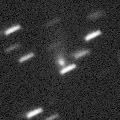
|
Now it is 15.6 mag (Feb. 18, Yuji Ohshima). It will brighten up to 9 mag in summer. However, it is hardly observable when it is bright. In the Northern Hemisphere, it is observable only until March when it brightens up to 14 mag. In the Southern Hemisphere, it is observable from July to September, but it locates in extremely low.
Date(TT) R.A. (2000) Decl. Delta r Elong. m1 Best Time(A, h)
Mar. 24 1 16.71 36 31.3 2.802 2.114 38 14.5 19:39 (124, 15)
Mar. 31 1 30.75 35 15.1 2.776 2.022 33 14.3 19:45 (126, 11)
|

|
It brightened up to 7.1 mag from May to June in 2017 (June 21, Juan Jose Gonzalez). Now it is fading. It has already faded down to 12.9 mag (Jan. 17, Chris Wyatt). In the Southern Hemisphere, it stays observable for a long time after this. However, it will be extremely low from January to March. It will never be observable again in the Northern Hemisphere.
Date(TT) R.A. (2000) Decl. Delta r Elong. m1 Best Time(A, h)
Mar. 24 0 1.18 -45 12.6 4.416 3.798 46 14.4 4:34 (304,-38)
Mar. 31 0 12.70 -44 38.4 4.447 3.864 48 14.5 4:23 (303,-37)
|
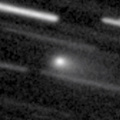
|
Now it is 16.0 mag (Mar. 14, Jean-Francois Soulier). It will be observable at 14 mag in good condition from spring to summer.
Date(TT) R.A. (2000) Decl. Delta r Elong. m1 Best Time(A, h)
Mar. 24 19 53.33 -27 53.6 1.748 1.661 68 14.6 4:34 (317, 12)
Mar. 31 20 14.69 -26 41.6 1.688 1.645 70 14.5 4:23 (316, 12)
|

|
Now it is 13.8 mag (Feb. 10, Chris Wyatt). It will be getting lower gradually after this in the evening sky. It will be unobservable in May.
Date(TT) R.A. (2000) Decl. Delta r Elong. m1 Best Time(A, h)
Mar. 24 3 36.41 5 34.0 2.703 2.221 51 14.7 19:39 ( 78, 26)
Mar. 31 3 47.15 8 22.0 2.809 2.258 47 14.8 19:45 ( 84, 23)
|

|
The condition of this apparition is worst. It brightens up to 12.5 mag from April to May. But it is not observable at all.
Date(TT) R.A. (2000) Decl. Delta r Elong. m1 Best Time(A, h)
Mar. 24 22 48.13 -3 45.5 1.755 0.903 21 16.1 4:34 (272, -4)
Mar. 31 23 23.72 -1 5.9 1.696 0.818 18 15.2 4:23 (267, -6)
|
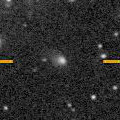
|
Now it is 15.7 mag (Mar. 16, Toshihiko Ikemura, Hirohisa Sato). It is expected to brighten up to 13-14 mag from 2018 to 2019. In the Northern Hemisphere, it stays observable in good condition for a long time. In the Southern Hemisphere, it locates extremely low until summer.
Date(TT) R.A. (2000) Decl. Delta r Elong. m1 Best Time(A, h)
Mar. 24 19 39.68 40 46.4 4.476 4.285 72 15.6 4:34 (247, 54)
Mar. 31 19 39.33 41 26.6 4.380 4.245 75 15.5 4:23 (246, 57)
|

|
Now it is 16.4 mag (Feb. 21, B. Lutkenhoner, K. Dankov). It stays 15 mag from 2018 to 2019, and it will be observable for a long time in the Southern Hemisphere. In the Northern Hemisphere, it will never be observable again.
Date(TT) R.A. (2000) Decl. Delta r Elong. m1 Best Time(A, h)
Mar. 24 13 53.52 -64 10.9 4.260 4.758 114 15.6 1:50 ( 0, -9)
Mar. 31 13 44.92 -65 18.6 4.181 4.726 117 15.6 1:14 ( 0,-10)
|
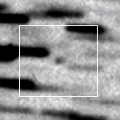
|
Now it is 17.1 mag (Mar. 24, Toshihiko Ikemura, Hirohisa Sato). It will brighten rapidly after this, and it will brighten up to 11 mag from summer to autumn. It is observable in excellent condition in the Southern Hemisphere. It locates somewhat low in the Northern Hemisphere.
Date(TT) R.A. (2000) Decl. Delta r Elong. m1 Best Time(A, h)
Mar. 24 19 53.85 -17 34.0 2.497 2.282 66 15.9 4:34 (310, 20)
Mar. 31 20 7.29 -17 15.5 2.400 2.258 69 15.6 4:23 (311, 21)
|
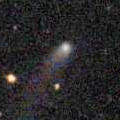
|
Now it is 16.2 mag (Mar. 11, Toshihiko Ikemura, Hirohisa Sato). It stays 16 mag for a long time from 2017 to 2018. It is observable in excellent condition in the Northern Hemisphere. It locates very low in the Southern Hemisphere.
Date(TT) R.A. (2000) Decl. Delta r Elong. m1 Best Time(A, h)
Mar. 24 7 13.64 43 54.1 5.135 5.403 100 15.7 19:39 (148, 79)
Mar. 31 7 10.15 44 8.3 5.263 5.412 93 15.8 19:45 (130, 74)
|

|
Appearing in the morning sky in the Southern Hemisphere. It is observable at 15 mag in good condition in 2018. It is not observable until May in the Northern Hemisphere.
Date(TT) R.A. (2000) Decl. Delta r Elong. m1 Best Time(A, h)
Mar. 24 21 47.88 -20 39.3 3.691 3.015 41 15.9 4:34 (294, -2)
Mar. 31 21 58.29 -19 58.7 3.636 3.024 45 15.9 4:23 (294, 0)
|

|
Now it is 16.1 mag (Mar. 12, Toshihiko Ikemura, Hirohisa Sato). It will be fading slowly until summer.
Date(TT) R.A. (2000) Decl. Delta r Elong. m1 Best Time(A, h)
Mar. 24 11 35.27 12 36.7 2.575 3.542 163 15.9 23:27 ( 0, 68)
Mar. 31 11 31.15 12 54.9 2.605 3.544 156 16.0 22:56 ( 0, 68)
|
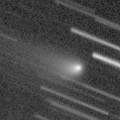
|
Appearing in the morning sky. It is fading now. But it stays 16 mag until summer. But actually, it is 18.1 mag (Mar. 23, Toshihiko Ikemura, Hirohisa Sato), fainter than this ephemeris.
Date(TT) R.A. (2000) Decl. Delta r Elong. m1 Best Time(A, h)
Mar. 24 19 17.94 -22 57.4 3.564 3.447 75 16.0 4:34 (321, 21)
Mar. 31 19 13.74 -23 27.0 3.465 3.489 83 16.0 4:23 (325, 23)
|

|
It brightened up to 8.1 mag in autumn (Oct. 3, Juan Jose Gonzalez). Now it is fading rapidly. It has already faded down to 17.9 mag (Mar. 11, Toshihiko Ikemura, Hirohisa Sato). In the Northern Hemisphere, it stays observable in good condition for a long time. In the Southern Hemisphere, it will never be observable again after this.
Date(TT) R.A. (2000) Decl. Delta r Elong. m1 Best Time(A, h)
Mar. 24 7 30.84 67 48.2 2.283 2.589 96 16.1 19:39 (178, 57)
Mar. 31 7 46.44 65 36.0 2.403 2.658 93 16.5 19:45 (174, 59)
|

|
It will brighten up to 16 mag in spring. In the Southern Hemisphere, it stays observable until August, but it will be unobservable after that. In the Northern Hemisphere, it stays unobservable until June, but it will be observable in good condition after that.
Date(TT) R.A. (2000) Decl. Delta r Elong. m1 Best Time(A, h)
Mar. 24 21 29.18 -41 34.6 1.638 1.366 56 16.3 4:34 (313,-11)
Mar. 31 22 0.14 -38 37.0 1.605 1.331 55 16.2 4:23 (309,-12)
|

|
Now it is 16.2 mag (Mar. 12, Toshihiko Ikemura, Hirohisa Sato). It will be fading slowly after this.
Date(TT) R.A. (2000) Decl. Delta r Elong. m1 Best Time(A, h)
Mar. 24 10 20.11 7 33.7 8.734 9.618 150 16.5 22:13 ( 0, 62)
Mar. 31 10 19.05 7 51.8 8.799 9.622 143 16.5 21:44 ( 0, 63)
|
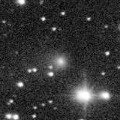
|
Now it is 16.4 mag (Mar. 14, Toshihiko Ikemura, Hirohisa Sato). It will be fading after this. In the Northern Hemisphere, it stays observable in the northern sky for a long time. It is not observable at all after this in the Southern Hemisphere.
Date(TT) R.A. (2000) Decl. Delta r Elong. m1 Best Time(A, h)
Mar. 24 22 19.60 79 26.0 3.714 3.665 79 16.7 4:34 (193, 35)
Mar. 31 22 46.48 81 37.9 3.762 3.698 78 16.7 4:23 (190, 35)
|

|
It brightened up to 9.7 mag in November (Nov. 16, Juan Jose Gonzalez). Now it is fading rapidly. It has already faded down to 15.9 mag (Mar. 13, Toshihiko Ikemura, Hirohisa Sato).
Date(TT) R.A. (2000) Decl. Delta r Elong. m1 Best Time(A, h)
Mar. 24 16 51.25 -12 40.8 1.382 1.959 109 16.7 4:34 (356, 42)
Mar. 31 16 51.44 -12 52.5 1.363 2.018 116 17.0 4:19 ( 0, 42)
|
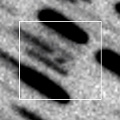
|
Now it is 18.6 mag (Mar. 13, Toshihiko Ikemura, Hirohisa Sato). It will brighten rapidly, and brighten up to 7 mag from August to September. In the Northern Hemisphere, it will be observable in excellent condition. In the Southern Hemisphere, it will be unobservable from July to August. But it will be observable in good condition before and after tha.
Date(TT) R.A. (2000) Decl. Delta r Elong. m1 Best Time(A, h)
Mar. 24 18 43.76 6 5.6 2.230 2.309 81 17.2 4:34 (308, 49)
Mar. 31 18 54.51 7 56.3 2.101 2.247 85 16.8 4:23 (308, 52)
|

|
Now it is 16.5 mag (Mar. 12, Toshihiko Ikemura, Hirohisa Sato). It has not been brightening well since the discovery in 2010. It is observable in good conditioin in the Northern Hemisphere. It is not observable for a long time in the Southern Hemisphere.
Date(TT) R.A. (2000) Decl. Delta r Elong. m1 Best Time(A, h)
Mar. 24 5 48.99 73 53.2 8.670 8.680 87 16.9 19:39 (168, 49)
Mar. 31 5 54.64 73 30.3 8.732 8.671 83 16.9 19:45 (166, 48)
|

|
Now it is 16.8 mag (Mar. 12, Toshihiko Ikemura, Hirohisa Sato). It will brighten up to 15 mag in January, 2019. It stays observable in excellent condition in the Northern Hemispehre. It is observable only until June in the Southern Hemisphere.
Date(TT) R.A. (2000) Decl. Delta r Elong. m1 Best Time(A, h)
Mar. 24 11 54.92 26 16.4 3.353 4.260 152 16.9 23:46 ( 0, 81)
Mar. 31 11 43.69 28 0.9 3.359 4.221 145 16.9 23:08 ( 0, 83)
|

|
Now it is 17.3 mag (Mar. 12, Toshihiko Ikemura, Hirohisa Sato). It will be fading after this, and it will be fainter than 18 mag in July.
Date(TT) R.A. (2000) Decl. Delta r Elong. m1 Best Time(A, h)
Mar. 24 12 6.67 19 54.3 4.638 5.579 158 16.9 0:03 ( 0, 75)
Mar. 31 12 0.10 21 12.0 4.693 5.603 153 17.0 23:24 ( 0, 76)
|

|
Now it is 16.7 mag (Mar. 17, Toshihiko Ikemura, Hirohisa Sato). It will be fading gradually after this, and it will be fainter than 18 mag in autumn. In the Northern Hemisphere, it stays observable in good condition for a long time. In the Southern Hemisphere, it will never be observable again.
Date(TT) R.A. (2000) Decl. Delta r Elong. m1 Best Time(A, h)
Mar. 24 21 53.19 63 53.6 7.331 7.011 67 16.9 4:34 (212, 36)
Mar. 31 22 3.76 64 35.1 7.371 7.033 66 17.0 4:23 (211, 37)
|
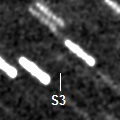
|
It is expected to approach to Sun down to 0.2 a.u. and brighten up to 3 mag in August. Now it is 18.7 mag (Toshihiko Ikemura, Hirohisa Sato), a bit fainter than this ephemeris. In the Northern Hemisphere, it stays observable in the morning sky until early August when the comet brightens up to 6 mag. It is not observable at all in the Southern Hemisphere.
Date(TT) R.A. (2000) Decl. Delta r Elong. m1 Best Time(A, h)
Mar. 24 22 33.55 51 48.7 3.302 2.843 54 17.1 4:34 (224, 28)
Mar. 31 22 47.47 52 7.7 3.223 2.745 53 16.9 4:23 (224, 28)
|

|
Now it is 16.8 mag (Mar. 15, iTelescope Observatory, Siding Spring). In the Southern Hemisphere, it is observable at 17 mag in good condition. It will be too low to observe in June. In the Northern Hemisphere, it locates extremely low only in spring.
Date(TT) R.A. (2000) Decl. Delta r Elong. m1 Best Time(A, h)
Mar. 24 5 0.23 -38 13.7 2.763 2.717 76 17.0 19:39 ( 32, 8)
Mar. 31 5 12.91 -35 15.4 2.784 2.711 75 17.0 19:45 ( 37, 8)
|
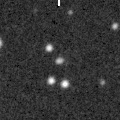
|
Now it is 17.0 mag (Mar. 13, Toshihiko Ikemura, Hirohisa Sato). It is observable at 17 mag in good condition in spring.
Date(TT) R.A. (2000) Decl. Delta r Elong. m1 Best Time(A, h)
Mar. 24 13 4.69 -13 20.1 1.584 2.551 162 17.1 1:01 ( 0, 42)
Mar. 31 13 0.98 -12 52.3 1.557 2.545 169 17.0 0:30 ( 0, 42)
|
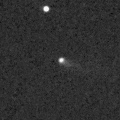
|
It brightened up to 15.7 mag in February (Feb. 11, Catalina Sky Survey). Now it is fading rapidly. It has already faded down to 16.9 mag (Mar. 24, Toshihiko Ikemura, Hirohisa Sato). It will be fainter than 18 mag in late April.
Date(TT) R.A. (2000) Decl. Delta r Elong. m1 Best Time(A, h)
Mar. 24 13 25.07 23 47.8 0.484 1.434 149 17.0 1:21 ( 0, 79)
Mar. 31 13 22.98 22 41.9 0.504 1.460 151 17.2 0:52 ( 0, 78)
|

|
Now it is 16.4 mag (Mar. 13, Toshihiko Ikemura, Hirohisa Sato). It will be fainter than 18 mag in summer.
Date(TT) R.A. (2000) Decl. Delta r Elong. m1 Best Time(A, h)
Mar. 24 15 2.11 -15 44.7 5.524 6.274 135 17.2 2:58 ( 0, 39)
Mar. 31 14 59.99 -14 53.6 5.463 6.290 143 17.2 2:28 ( 0, 40)
|

|
Now it is 18.7 mag (Mar. 14, Toshihiko Ikemura, Hirohisa Sato). It stays observable at 17-18 mag in good condition for a while.
Date(TT) R.A. (2000) Decl. Delta r Elong. m1 Best Time(A, h)
Mar. 24 15 21.55 -6 27.4 1.822 2.599 132 17.2 3:17 ( 0, 48)
Mar. 31 15 19.21 -5 58.2 1.794 2.635 139 17.2 2:48 ( 0, 49)
|
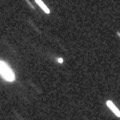
|
Now it is 17.1 mag (Mar. 12, Toshihiko Ikemura, Hirohisa Sato). It will be fading gradually after this.
Date(TT) R.A. (2000) Decl. Delta r Elong. m1 Best Time(A, h)
Mar. 24 11 3.66 39 43.6 7.431 8.180 136 17.3 22:56 (180, 85)
Mar. 31 10 58.62 39 25.0 7.509 8.200 131 17.3 22:23 (180, 86)
|

|
Now it is 18.5 mag (Mar. 13, Toshihiko Ikemura, Hirohisa Sato). It will be fading after this.
Date(TT) R.A. (2000) Decl. Delta r Elong. m1 Best Time(A, h)
Mar. 24 9 24.12 -14 31.9 2.540 3.336 136 17.8 21:17 ( 0, 40)
Mar. 31 9 23.92 -14 3.1 2.633 3.378 131 18.0 20:49 ( 0, 41)
|

|
Now it is 19.7 mag (Mar. 24, Toshihiko Ikemura, Hirohisa Sato). It was predicted to be observable at 17.5 mag in good condition from spring to summer. But recently, it is fainter than predicted.
Date(TT) R.A. (2000) Decl. Delta r Elong. m1 Best Time(A, h)
Mar. 24 16 37.12 -9 3.6 3.382 3.887 113 17.9 4:33 ( 0, 46)
Mar. 31 16 37.88 -8 52.9 3.289 3.886 119 17.9 4:06 ( 0, 46)
|
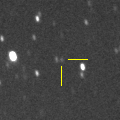
|
Now it is 18.0 mag (Feb. 12, Toshihiko Ikemura, Hirohisa Sato). It stays 18 mag from 2018 to 2020. It is observable in good condition in the Southern Hemisphere. It locates extremely low in the Northern Hemisphere.
Date(TT) R.A. (2000) Decl. Delta r Elong. m1 Best Time(A, h)
Mar. 24 12 52.62 -38 10.7 3.710 4.536 141 17.9 0:49 ( 0, 17)
Mar. 31 12 47.50 -38 18.4 3.672 4.532 145 17.9 0:16 ( 0, 17)
|

|
It has passed the perihelion on Jan. 23, and it approached to the Sun down to 0.1 a.u. Now it is 19.1 mag (Mar. 24, Steward Observatory, Mt. Lemmon Station). It is observable at 19.5 mag in good condition in March.
Date(TT) R.A. (2000) Decl. Delta r Elong. m1 Best Time(A, h)
Mar. 24 13 8.27 -12 53.8 0.463 1.444 161 19.6 1:07 ( 0, 42)
Mar. 31 12 29.54 -7 53.1 0.553 1.551 175 19.7 23:51 ( 0, 47)
|
|
![]()
 C/2017 M4 ( ATLAS )
C/2017 M4 ( ATLAS ) C/2017 B3 ( LINEAR )
C/2017 B3 ( LINEAR ) 48P/Johnson
48P/Johnson C/2016 A1 ( PanSTARRS )
C/2016 A1 ( PanSTARRS ) 65P/Gunn
65P/Gunn 74P/Smirnova-Chernykh
74P/Smirnova-Chernykh C/2015 VL62 ( Lemmon-Yeung-PanSTARRS )
C/2015 VL62 ( Lemmon-Yeung-PanSTARRS ) C/2017 O1 ( ASASSN )
C/2017 O1 ( ASASSN ) (3552) Don Quixote
(3552) Don Quixote C/2014 B1 ( Schwartz )
C/2014 B1 ( Schwartz ) C/2016 N4 ( MASTER )
C/2016 N4 ( MASTER ) 24P/Schaumasse
24P/Schaumasse 21P/Giacobini-Zinner
21P/Giacobini-Zinner C/2010 U3 ( Boattini )
C/2010 U3 ( Boattini ) C/2018 A3 ( ATLAS )
C/2018 A3 ( ATLAS ) C/2017 D3 ( ATLAS )
C/2017 D3 ( ATLAS ) C/2014 OE4 ( PanSTARRS )
C/2014 OE4 ( PanSTARRS ) C/2017 S3 ( PanSTARRS )
C/2017 S3 ( PanSTARRS ) C/2018 E1 ( ATLAS )
C/2018 E1 ( ATLAS ) 143P/Kowal-Mrkos
143P/Kowal-Mrkos 365P/2017 U6 ( PanSTARRS )
365P/2017 U6 ( PanSTARRS ) C/2017 E3 ( PanSTARRS )
C/2017 E3 ( PanSTARRS ) 30P/Reinmuth 1
30P/Reinmuth 1 C/2014 R3 ( PanSTARRS )
C/2014 R3 ( PanSTARRS ) C/2016 T3 ( PanSTARRS )
C/2016 T3 ( PanSTARRS ) 187P/LINEAR
187P/LINEAR 186P/Garradd
186P/Garradd 2011 KE
2011 KE![]()




































